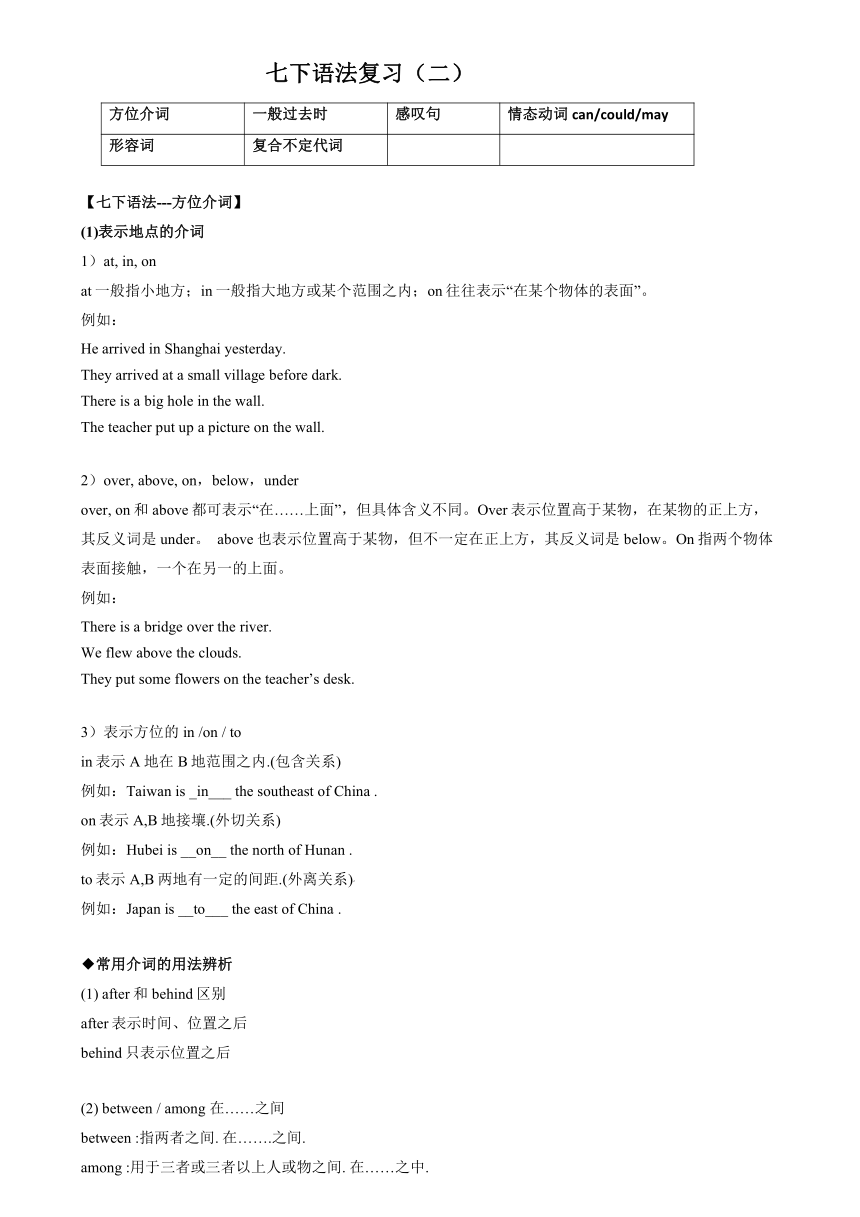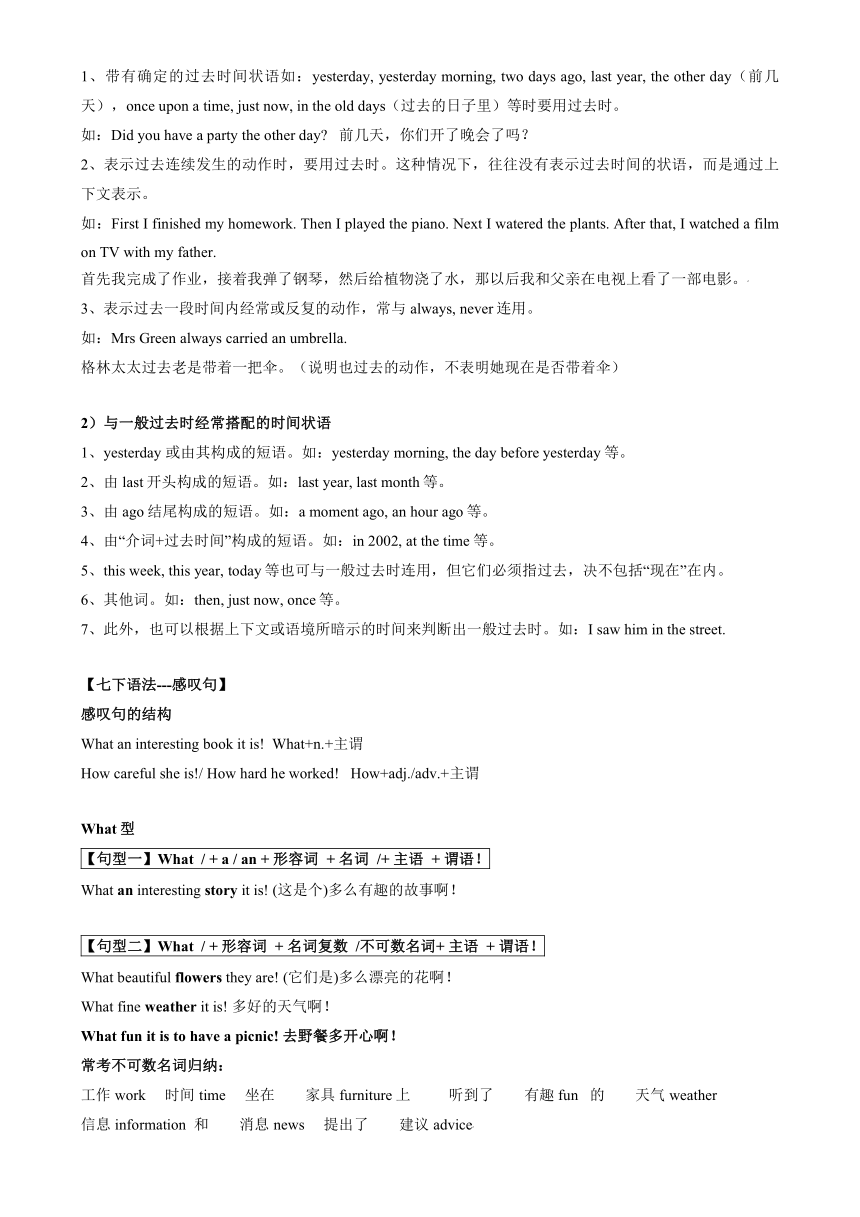2023~2024学年七下第二学期初中英语期末知识点复习:语法复习(二)(牛津译林版)
文档属性
| 名称 | 2023~2024学年七下第二学期初中英语期末知识点复习:语法复习(二)(牛津译林版) |  | |
| 格式 | docx | ||
| 文件大小 | 37.9KB | ||
| 资源类型 | 教案 | ||
| 版本资源 | 牛津译林版 | ||
| 科目 | 英语 | ||
| 更新时间 | 2024-05-21 06:40:51 | ||
图片预览



文档简介
七下语法复习(二)
方位介词 一般过去时 感叹句 情态动词can/could/may
形容词 复合不定代词
【七下语法---方位介词】
(1)表示地点的介词
1)at, in, on
at一般指小地方;in一般指大地方或某个范围之内;on往往表示“在某个物体的表面”。
例如:
He arrived in Shanghai yesterday.
They arrived at a small village before dark.
There is a big hole in the wall.
The teacher put up a picture on the wall.
2)over, above, on,below,under
over, on和above都可表示“在……上面”,但具体含义不同。Over表示位置高于某物,在某物的正上方,其反义词是under。 above也表示位置高于某物,但不一定在正上方,其反义词是below。On指两个物体表面接触,一个在另一的上面。
例如:
There is a bridge over the river.
We flew above the clouds.
They put some flowers on the teacher’s desk.
3)表示方位的in /on / to
in表示A地在B地范围之内.(包含关系)
例如:Taiwan is _in___ the southeast of China .
on表示A,B地接壤.(外切关系)
例如:Hubei is __on__ the north of Hunan .
to表示A,B两地有一定的间距.(外离关系)
例如:Japan is __to___ the east of China .
◆常用介词的用法辨析
(1) after和behind区别
after表示时间、位置之后
behind只表示位置之后
(2) between / among 在……之间
between :指两者之间. 在…….之间.
among :用于三者或三者以上人或物之间. 在……之中.
(3)on the tree /in the tree
on the tree 表示 “树上本身长的东西” 在树上.
in the tree 表示 “外界的物体进入树中” 人或物在树上.
(4) across / through / over / by 经过
across 指横穿,穿过. 表示从......表面上经过.
through 指穿过,透过,表示从某一物体空间内通过.
over 表示从某人或某物的上空经过或越过,不与表面接触.
by 表示从某人/某物的旁边经过.
例如:
Can you swim across the river
The elephant is so big that it can’ t go through the gate.
I don’ t think anyone can jump over the fence.
I walked by the bank of China yesterday.
(5) for, to和towards的区别
for 常用在leave,start后,表示运动的方向和目的,如leave for Beijing
to 常用在go, come, return, move等词之后,如return to school
towards 意为“朝,向”,只是说明运动的方向,没有“到达”之意,如walk towards us
in front of, in the front of
in front of 表示“在某人或某物的前面”,在某个范围以外,反义词behind;in the front of 表示“在……的前部”,在某个范围以内,反义短语“at the back of”。
例如:
There are some tall trees in front of the building.
The teacher is sitting in the front of the classroom.
beside, next to与near
beside指“在......旁边/附近”,可等于near。next to表“紧挨着,紧靠着”。
例如:
Come and sit beside/near me.
The pretty boy is standing next to the window.
inside与outside
inside 在......里面
outside 在......外面
【七下语法---一般过去时】
1)一般过去时的基本用法
1、带有确定的过去时间状语如:yesterday, yesterday morning, two days ago, last year, the other day(前几天),once upon a time, just now, in the old days(过去的日子里)等时要用过去时。
如:Did you have a party the other day 前几天,你们开了晚会了吗?
2、表示过去连续发生的动作时,要用过去时。这种情况下,往往没有表示过去时间的状语,而是通过上下文表示。
如:First I finished my homework. Then I played the piano. Next I watered the plants. After that, I watched a film on TV with my father.
首先我完成了作业,接着我弹了钢琴,然后给植物浇了水,那以后我和父亲在电视上看了一部电影。
3、表示过去一段时间内经常或反复的动作,常与always, never连用。
如:Mrs Green always carried an umbrella.
格林太太过去老是带着一把伞。(说明也过去的动作,不表明她现在是否带着伞)
2)与一般过去时经常搭配的时间状语
1、yesterday 或由其构成的短语。如:yesterday morning, the day before yesterday等。
2、由last开头构成的短语。如:last year, last month等。
3、由ago结尾构成的短语。如:a moment ago, an hour ago等。
4、由“介词+过去时间”构成的短语。如:in 2002, at the time等。
5、this week, this year, today等也可与一般过去时连用,但它们必须指过去,决不包括“现在”在内。
6、其他词。如:then, just now, once等。
7、此外,也可以根据上下文或语境所暗示的时间来判断出一般过去时。如:I saw him in the street.
【七下语法---感叹句】
感叹句的结构
What an interesting book it is! What+n.+主谓
How careful she is!/ How hard he worked! How+adj./adv.+主谓
What型
【句型一】What / + a / an + 形容词 + 名词 /+ 主语 + 谓语!
What an interesting story it is! (这是个)多么有趣的故事啊!
【句型二】What / + 形容词 + 名词复数 /不可数名词+ 主语 + 谓语!
What beautiful flowers they are! (它们是)多么漂亮的花啊!
What fine weather it is! 多好的天气啊!
What fun it is to have a picnic! 去野餐多开心啊!
常考不可数名词归纳:
工作work 时间time 坐在 家具furniture上 听到了 有趣fun 的 天气weather
信息information 和 消息news 提出了 建议advice
How型
【句型】How /+ 形容词 / 副词 / + 主语 + 谓语!
How clever the boy is! 这个男孩多么聪明啊!
How fast he runs! 他跑得多么快啊!
感叹句题的做题步骤:
1. 找所要求改写的句子的主谓,先找谓语动词,再找主语;
2. 划去主谓后剩形容词或副词则选how;剩含有形容词的名词短语或名词,则选what;
3. 选用what时,切记要看名词是可数还是不可数,可数时是元音音素开头还是辅音音素开头。
【七下语法—情态动词can/could/may】
情态动词can,could和may的用法
1、情态动词的句式结构
句式 构成 例句
肯定句 主语+情态动词+动词原形+其他. We can see a picture on the wall. 我们能看到墙上有幅画。
否定句 主语+情态动词+not+动词原形+其他. We can’t see the words clearly. 我们不能清楚地看到那些单词。
一般疑问句 情态动词+主语+动词原形+其他? Yes,主语+情态动词. No,主语+情态动词+not. —Can you play the computer game?你能玩电脑游戏吗? —Yes,I can./No,I can’t. 是的,我能。/不,我不能。
特殊疑问句 特殊疑问词+一般疑问句? What can I do next?下一步我能做什么?
2、can的用法
规则说明 例句
1.表示一个人现在的体力或脑力方面的能力,意为“会,能够”。 He can speak a little English now. 他现在会说一点儿英语了。
2.表示客观可能性,意为“可能,可以”。 Kate can also get lost near her home. 凯特在她家附近也能迷路。 My father can be at home now. 我父亲现在可能在家里。
3.can可用来表示委婉的请求或许可,一般常用于口语中,但它不如may正式,也不如could语气委婉。 Can I look at your new MP3?我可以看看你的新MP3吗?
4.用于否定句或疑问句中,表示推测或猜测,意为“可能”,can’t意为“不可能”。 This can’t be true. 这不可能是真的。
注意:
⑴can和not可缩写为cannot或can’t,但不能写成cann’t。
⑵以can开头的一般疑问句,肯定回答为:Yes,主语+can.,也可用OK.或Certainly.来回答。否定回答为:No,主语+can’t.,也可用Sorry.来回答。
⑶我们也可以用be able to do sth.表示一个人的能力,be动词的形式根据句子的时态变化。
3、could的用法
规则说明 例句
1.could是can的过去式,表示过去的能力,意为“能,会”。 He could swim when he was four years old. 他四岁时就会游泳了。
2.could表示过去的可能和许可,意为“可能,可以”。 He said we could use his computer. 他说我们可以用他的电脑。
3.could表示现在的能力时,语气比can要委婉。 Maybe we could talk about English names. 也许我们能谈谈英国人的名字。
4.could表示现在的许可时,主要用于疑问句中,这时其回答要用can。 —Could I put my coat here?我能把外套放在这儿吗? —Yes,you can.是的,你能。 —No,you can’t. 不,你不能。
4、may的用法
规则说明 例句
1.may可以表示一种可能性,意思是“可能,也许”。 The story may not be true. 这个故事也许不是真的。
2.may可以表示许可,意思是“可以”,表示说话人同意,或在疑问句中征询对方的许可。 You may go home now. 你现在可以回家了。 May I come in?我可以进来吗?
3.may可以表示祝愿、希望等,用于“May+主语+动词”结构,表示“祝愿”。 May you succeed!祝你成功!
注意:
⑴can’t表示“不可能”,may not表示“可能不”,两者用法不同。例如:
Mr. Wang can’t be in this afternoon. 王先生今天下午不可能在家。
Mr. Wang may not be in this afternoon. 王先生今天下午可能不在家。
⑵以may开头的疑问句的回答,通常比较灵活。肯定回答除了用Yes,you may.之外,还可以委婉地说:Yes,please./Certainly./Of course.等;否定回答一般用No,you mustn’t.还可以委婉地说:Please don’t./Sorry,you can’t.
【七下语法—形容词】
形容词描述人或事物,一般把形容词放在名词前面或系动词的后面。
例如:Tom is shy.(放在be动词的后面)
Tom looks shy.(放在系动词的后面)
Tom is a shy boy. (放在名词的前面)
【注意】
1)形容词一般放在不定代词的后面。
例如:something interesting 有趣的事情
2)形容词一般放在enough的前面。
例如:interesting enough 足够的有趣
几种系动词:五变五起来,好像是保持
五变:become, turn, get, grow, go
五起来:smell, sound, taste, feel, look
好像:seem
是:be
保持:keep, stay
【七下语法—复合不定代词】
复合不定代词的用法
一、构成:
1.指物:something anything everything nothing
2.指人:somebody anybody everybody nobody
someone anyone everyone no one
二、用法:
1.复合不定代词在句中充当主语、宾语、表语;做主语时,谓语动词用单数。
例:Everything begins to grow when spring comes.
Everybody is here except(除了)Tom.
2.形容词修饰不定代词要后置。
例:There is nothing wrong with my car.
The government(政府)is doing something useful to protect the environment(环境).
Is there anyone else in the room
3. something, somebody, someone通常用于肯定句;anything, anyone, anybody通常用于否定句﹑一般疑问句或条件状语从句中。
例:He found something strange but interesting.
Do you have anything to say ?
I didn’t meet anybody on the road.
I met nobody on the road.
Please tell him I am not here if anyone asks where I am.
4.在疑问句中,表示邀请、请求、建议,希望得到对方肯定回答时,用something, somebody, someone。
例:Would you like something to drink/eat
5.肯定句中,anything 在表示 “任何事(物)”,anyone,anybody表示“无论谁,任何人”。
例:Anything is OK.
I would like to do anything for you.
方位介词 一般过去时 感叹句 情态动词can/could/may
形容词 复合不定代词
【七下语法---方位介词】
(1)表示地点的介词
1)at, in, on
at一般指小地方;in一般指大地方或某个范围之内;on往往表示“在某个物体的表面”。
例如:
He arrived in Shanghai yesterday.
They arrived at a small village before dark.
There is a big hole in the wall.
The teacher put up a picture on the wall.
2)over, above, on,below,under
over, on和above都可表示“在……上面”,但具体含义不同。Over表示位置高于某物,在某物的正上方,其反义词是under。 above也表示位置高于某物,但不一定在正上方,其反义词是below。On指两个物体表面接触,一个在另一的上面。
例如:
There is a bridge over the river.
We flew above the clouds.
They put some flowers on the teacher’s desk.
3)表示方位的in /on / to
in表示A地在B地范围之内.(包含关系)
例如:Taiwan is _in___ the southeast of China .
on表示A,B地接壤.(外切关系)
例如:Hubei is __on__ the north of Hunan .
to表示A,B两地有一定的间距.(外离关系)
例如:Japan is __to___ the east of China .
◆常用介词的用法辨析
(1) after和behind区别
after表示时间、位置之后
behind只表示位置之后
(2) between / among 在……之间
between :指两者之间. 在…….之间.
among :用于三者或三者以上人或物之间. 在……之中.
(3)on the tree /in the tree
on the tree 表示 “树上本身长的东西” 在树上.
in the tree 表示 “外界的物体进入树中” 人或物在树上.
(4) across / through / over / by 经过
across 指横穿,穿过. 表示从......表面上经过.
through 指穿过,透过,表示从某一物体空间内通过.
over 表示从某人或某物的上空经过或越过,不与表面接触.
by 表示从某人/某物的旁边经过.
例如:
Can you swim across the river
The elephant is so big that it can’ t go through the gate.
I don’ t think anyone can jump over the fence.
I walked by the bank of China yesterday.
(5) for, to和towards的区别
for 常用在leave,start后,表示运动的方向和目的,如leave for Beijing
to 常用在go, come, return, move等词之后,如return to school
towards 意为“朝,向”,只是说明运动的方向,没有“到达”之意,如walk towards us
in front of, in the front of
in front of 表示“在某人或某物的前面”,在某个范围以外,反义词behind;in the front of 表示“在……的前部”,在某个范围以内,反义短语“at the back of”。
例如:
There are some tall trees in front of the building.
The teacher is sitting in the front of the classroom.
beside, next to与near
beside指“在......旁边/附近”,可等于near。next to表“紧挨着,紧靠着”。
例如:
Come and sit beside/near me.
The pretty boy is standing next to the window.
inside与outside
inside 在......里面
outside 在......外面
【七下语法---一般过去时】
1)一般过去时的基本用法
1、带有确定的过去时间状语如:yesterday, yesterday morning, two days ago, last year, the other day(前几天),once upon a time, just now, in the old days(过去的日子里)等时要用过去时。
如:Did you have a party the other day 前几天,你们开了晚会了吗?
2、表示过去连续发生的动作时,要用过去时。这种情况下,往往没有表示过去时间的状语,而是通过上下文表示。
如:First I finished my homework. Then I played the piano. Next I watered the plants. After that, I watched a film on TV with my father.
首先我完成了作业,接着我弹了钢琴,然后给植物浇了水,那以后我和父亲在电视上看了一部电影。
3、表示过去一段时间内经常或反复的动作,常与always, never连用。
如:Mrs Green always carried an umbrella.
格林太太过去老是带着一把伞。(说明也过去的动作,不表明她现在是否带着伞)
2)与一般过去时经常搭配的时间状语
1、yesterday 或由其构成的短语。如:yesterday morning, the day before yesterday等。
2、由last开头构成的短语。如:last year, last month等。
3、由ago结尾构成的短语。如:a moment ago, an hour ago等。
4、由“介词+过去时间”构成的短语。如:in 2002, at the time等。
5、this week, this year, today等也可与一般过去时连用,但它们必须指过去,决不包括“现在”在内。
6、其他词。如:then, just now, once等。
7、此外,也可以根据上下文或语境所暗示的时间来判断出一般过去时。如:I saw him in the street.
【七下语法---感叹句】
感叹句的结构
What an interesting book it is! What+n.+主谓
How careful she is!/ How hard he worked! How+adj./adv.+主谓
What型
【句型一】What / + a / an + 形容词 + 名词 /+ 主语 + 谓语!
What an interesting story it is! (这是个)多么有趣的故事啊!
【句型二】What / + 形容词 + 名词复数 /不可数名词+ 主语 + 谓语!
What beautiful flowers they are! (它们是)多么漂亮的花啊!
What fine weather it is! 多好的天气啊!
What fun it is to have a picnic! 去野餐多开心啊!
常考不可数名词归纳:
工作work 时间time 坐在 家具furniture上 听到了 有趣fun 的 天气weather
信息information 和 消息news 提出了 建议advice
How型
【句型】How /+ 形容词 / 副词 / + 主语 + 谓语!
How clever the boy is! 这个男孩多么聪明啊!
How fast he runs! 他跑得多么快啊!
感叹句题的做题步骤:
1. 找所要求改写的句子的主谓,先找谓语动词,再找主语;
2. 划去主谓后剩形容词或副词则选how;剩含有形容词的名词短语或名词,则选what;
3. 选用what时,切记要看名词是可数还是不可数,可数时是元音音素开头还是辅音音素开头。
【七下语法—情态动词can/could/may】
情态动词can,could和may的用法
1、情态动词的句式结构
句式 构成 例句
肯定句 主语+情态动词+动词原形+其他. We can see a picture on the wall. 我们能看到墙上有幅画。
否定句 主语+情态动词+not+动词原形+其他. We can’t see the words clearly. 我们不能清楚地看到那些单词。
一般疑问句 情态动词+主语+动词原形+其他? Yes,主语+情态动词. No,主语+情态动词+not. —Can you play the computer game?你能玩电脑游戏吗? —Yes,I can./No,I can’t. 是的,我能。/不,我不能。
特殊疑问句 特殊疑问词+一般疑问句? What can I do next?下一步我能做什么?
2、can的用法
规则说明 例句
1.表示一个人现在的体力或脑力方面的能力,意为“会,能够”。 He can speak a little English now. 他现在会说一点儿英语了。
2.表示客观可能性,意为“可能,可以”。 Kate can also get lost near her home. 凯特在她家附近也能迷路。 My father can be at home now. 我父亲现在可能在家里。
3.can可用来表示委婉的请求或许可,一般常用于口语中,但它不如may正式,也不如could语气委婉。 Can I look at your new MP3?我可以看看你的新MP3吗?
4.用于否定句或疑问句中,表示推测或猜测,意为“可能”,can’t意为“不可能”。 This can’t be true. 这不可能是真的。
注意:
⑴can和not可缩写为cannot或can’t,但不能写成cann’t。
⑵以can开头的一般疑问句,肯定回答为:Yes,主语+can.,也可用OK.或Certainly.来回答。否定回答为:No,主语+can’t.,也可用Sorry.来回答。
⑶我们也可以用be able to do sth.表示一个人的能力,be动词的形式根据句子的时态变化。
3、could的用法
规则说明 例句
1.could是can的过去式,表示过去的能力,意为“能,会”。 He could swim when he was four years old. 他四岁时就会游泳了。
2.could表示过去的可能和许可,意为“可能,可以”。 He said we could use his computer. 他说我们可以用他的电脑。
3.could表示现在的能力时,语气比can要委婉。 Maybe we could talk about English names. 也许我们能谈谈英国人的名字。
4.could表示现在的许可时,主要用于疑问句中,这时其回答要用can。 —Could I put my coat here?我能把外套放在这儿吗? —Yes,you can.是的,你能。 —No,you can’t. 不,你不能。
4、may的用法
规则说明 例句
1.may可以表示一种可能性,意思是“可能,也许”。 The story may not be true. 这个故事也许不是真的。
2.may可以表示许可,意思是“可以”,表示说话人同意,或在疑问句中征询对方的许可。 You may go home now. 你现在可以回家了。 May I come in?我可以进来吗?
3.may可以表示祝愿、希望等,用于“May+主语+动词”结构,表示“祝愿”。 May you succeed!祝你成功!
注意:
⑴can’t表示“不可能”,may not表示“可能不”,两者用法不同。例如:
Mr. Wang can’t be in this afternoon. 王先生今天下午不可能在家。
Mr. Wang may not be in this afternoon. 王先生今天下午可能不在家。
⑵以may开头的疑问句的回答,通常比较灵活。肯定回答除了用Yes,you may.之外,还可以委婉地说:Yes,please./Certainly./Of course.等;否定回答一般用No,you mustn’t.还可以委婉地说:Please don’t./Sorry,you can’t.
【七下语法—形容词】
形容词描述人或事物,一般把形容词放在名词前面或系动词的后面。
例如:Tom is shy.(放在be动词的后面)
Tom looks shy.(放在系动词的后面)
Tom is a shy boy. (放在名词的前面)
【注意】
1)形容词一般放在不定代词的后面。
例如:something interesting 有趣的事情
2)形容词一般放在enough的前面。
例如:interesting enough 足够的有趣
几种系动词:五变五起来,好像是保持
五变:become, turn, get, grow, go
五起来:smell, sound, taste, feel, look
好像:seem
是:be
保持:keep, stay
【七下语法—复合不定代词】
复合不定代词的用法
一、构成:
1.指物:something anything everything nothing
2.指人:somebody anybody everybody nobody
someone anyone everyone no one
二、用法:
1.复合不定代词在句中充当主语、宾语、表语;做主语时,谓语动词用单数。
例:Everything begins to grow when spring comes.
Everybody is here except(除了)Tom.
2.形容词修饰不定代词要后置。
例:There is nothing wrong with my car.
The government(政府)is doing something useful to protect the environment(环境).
Is there anyone else in the room
3. something, somebody, someone通常用于肯定句;anything, anyone, anybody通常用于否定句﹑一般疑问句或条件状语从句中。
例:He found something strange but interesting.
Do you have anything to say ?
I didn’t meet anybody on the road.
I met nobody on the road.
Please tell him I am not here if anyone asks where I am.
4.在疑问句中,表示邀请、请求、建议,希望得到对方肯定回答时,用something, somebody, someone。
例:Would you like something to drink/eat
5.肯定句中,anything 在表示 “任何事(物)”,anyone,anybody表示“无论谁,任何人”。
例:Anything is OK.
I would like to do anything for you.
同课章节目录
